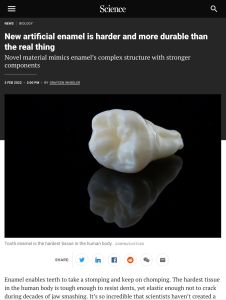Join getAbstract to access the summary!

Join getAbstract to access the summary!
Graycen Wheeler
New Artificial Enamel is Harder and More Durable Than the Real Thing
Novel material mimics enamel’s complex structure with stronger components
Science, 2022
What's inside?
Scientists have crafted a durable artificial enamel that may work in applications beyond tooth repair.
Recommendation
After years of effort, scientists have finally created a substance that proves as durable and flexible as human tooth enamel. Issues persist, such as finding a way to bond artificial enamel with natural tooth material. But researchers remain excited about the possibilities of applying artificial enamel in areas of tooth repair, electronics and infrastructure.
Summary
About the Author
Graycen Wheeler is a contributing writer to Science magazine. She is a master’s student in the science communication program at the University of California, Santa Cruz. She completed a PhD in biochemistry at the University of Colorado Boulder.



















Comment on this summary